Physical Address
304 North Cardinal St.
Dorchester Center, MA 02124
![]() Additional content is available online at Elsevier eBooks for Practicing Clinicians
Additional content is available online at Elsevier eBooks for Practicing Clinicians
Cardiovascular disease remains the leading cause of death worldwide, accounting for approximately 18 million deaths in 2017, with most deaths (approximately 70%) now occurring in low- and middle-income countries ( eFig. 25.1 ) (see Chapter 2 ). During the past decade, total cardiovascular disease deaths have increased globally by approximately 20%, at the same time that the age-adjusted cardiovascular deaths have decreased by approximately 10%. Total death rates are based on the total number of cardiovascular deaths divided by the population, while age-adjusted rates remove variations from differences in age structures in populations. Despite the decline in age-adjusted cardiovascular death rates, the total number of cardiovascular deaths have increased due to both population growth and aging, and in some countries also due to increases in age-specific cardiovascular mortality rates which may relate to rising obesity and diabetes rates.
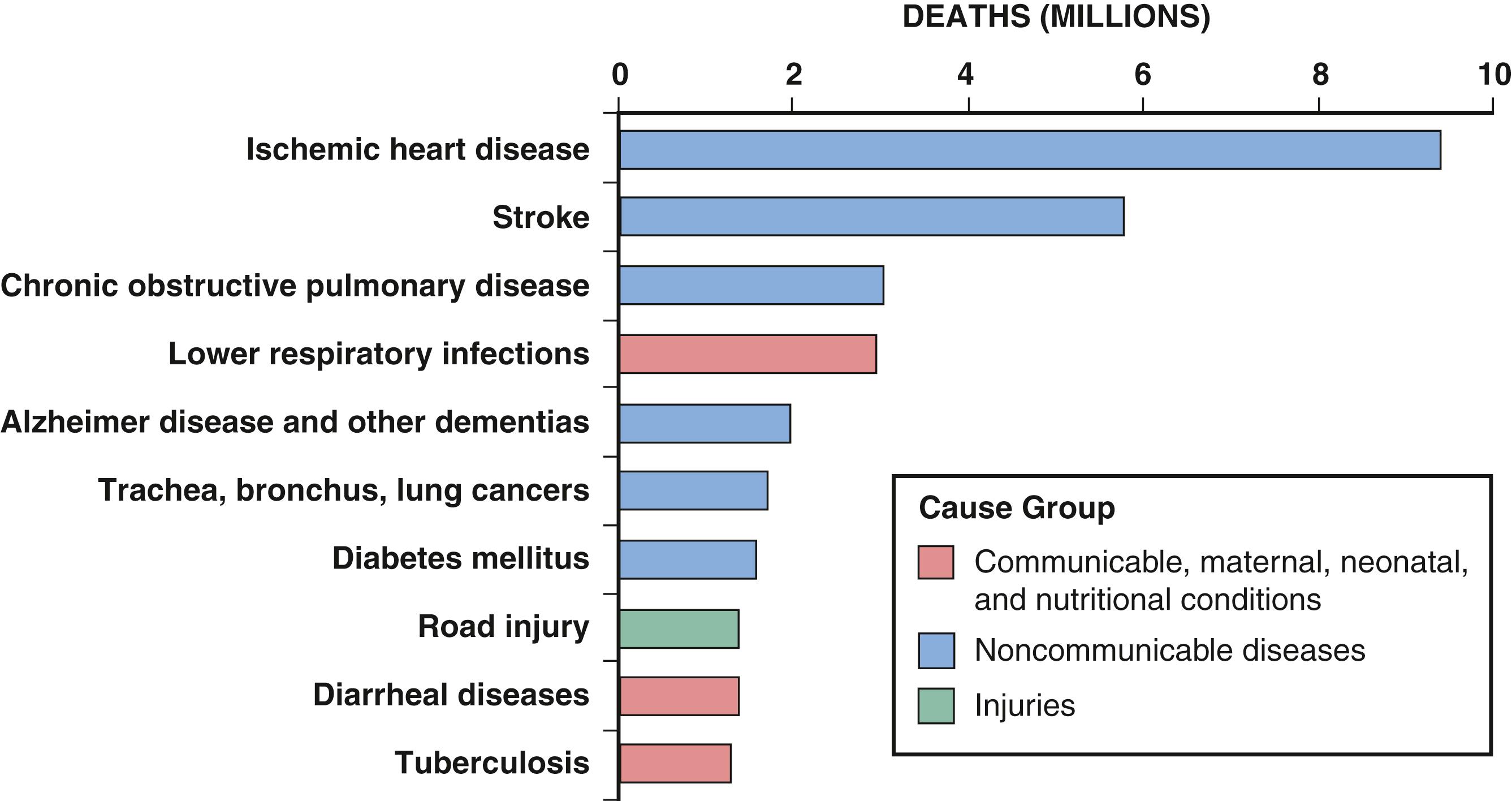
The age-adjusted decline in deaths from ischemic heart disease and stroke in high-income countries since the mid-1970s results from advances in both prevention (improvement in risk factors) and treatment (improvement in medical and surgical interventions), with each of prevention and treatment accounting for approximately half the decline. The age-adjusted rate of cardiovascular disease disability-adjusted life-years (DALYs) has also improved over the past several decades, but significant variations by country result from differences in risk factor prevalence and control. The largest contributors to the age-adjusted decline in cardiovascular death are lower cholesterol and blood pressure and smoking cessation. On the other hand, increases in ischemic heart disease mortality in China may relate to increases in smoking and cholesterol, while rates have increased in Mexico due to increases in obesity and diabetes. These observations underscore the importance of preventing and treating cardiovascular risk factors to reduce disparities in mortality. Recent global increases in obesity and diabetes and their long-term consequences on cardiovascular mortality currently present enormous challenges in cardiovascular prevention and controlling cardiovascular mortality. The decline in age-adjusted cardiovascular disease burden over the past several decades has recently slowed, requiring new global preventive measures.
Over the past 50 years, age-adjusted cardiovascular and ischemic heart disease death rates in the United States have declined by half. The annual incidence of coronary heart disease hospitalizations in the United States is estimated at 720,000 for new events and 335,000 for recurrent events per year, and for stroke the estimates are 610,000 new and 185,000 recurrent strokes per year. Incidence of myocardial infarction has declined, with the greatest decrease in pre-hospital fatal events. The US age-adjusted rate of cardiovascular disease DALYs has also improved over the past few decades. Yet substantial disparities across the key demographic categories persist, including geographic, socioeconomic, education, sex, race, and ethnicity variation, and in some cases the disparities have increased with growing economic inequality (see Chapter 6, Chapter 93 ). The greatest cardiovascular disease burden is in the stroke belt of the southeastern United States along the Mississippi River, and worse in blacks regardless of age. These disparities link closely to differences in the prevalence of major cardiovascular risk factors, highlighting the importance of prevention in reducing cardiovascular disparities and mortality.
Furthermore, cardiovascular disease accounts for 14% of US health expenditures and is projected to increase substantially over the next decade. Precision medicine approaches, such as the National Institutes of Health All of Us program that is collecting cardiovascular risk factor and event data over time in ≥ 1 million US participants will contribute to understanding future trends and more precise strategies for the prevention and treatment of cardiovascular disease.
Primordial prevention is the prevention of the development of risk factors, while primary prevention aims to prevent the clinical manifestation of cardiovascular disease in individuals without clinical cardiovascular disease ( Fig. 25.1 ). Primordial prevention focuses on social determinants of health and health inequities (e.g., poverty and living conditions, urbanization, air pollution, education, sedentary behavior, psychosocial stress), while primary prevention focuses on controlling cardiovascular risk factors among high-risk individuals through lifestyle approaches and treatment of established risk factors. On the other hand, secondary prevention targets patients with established disease to reduce risk of recurrent cardiovascular events and mortality.
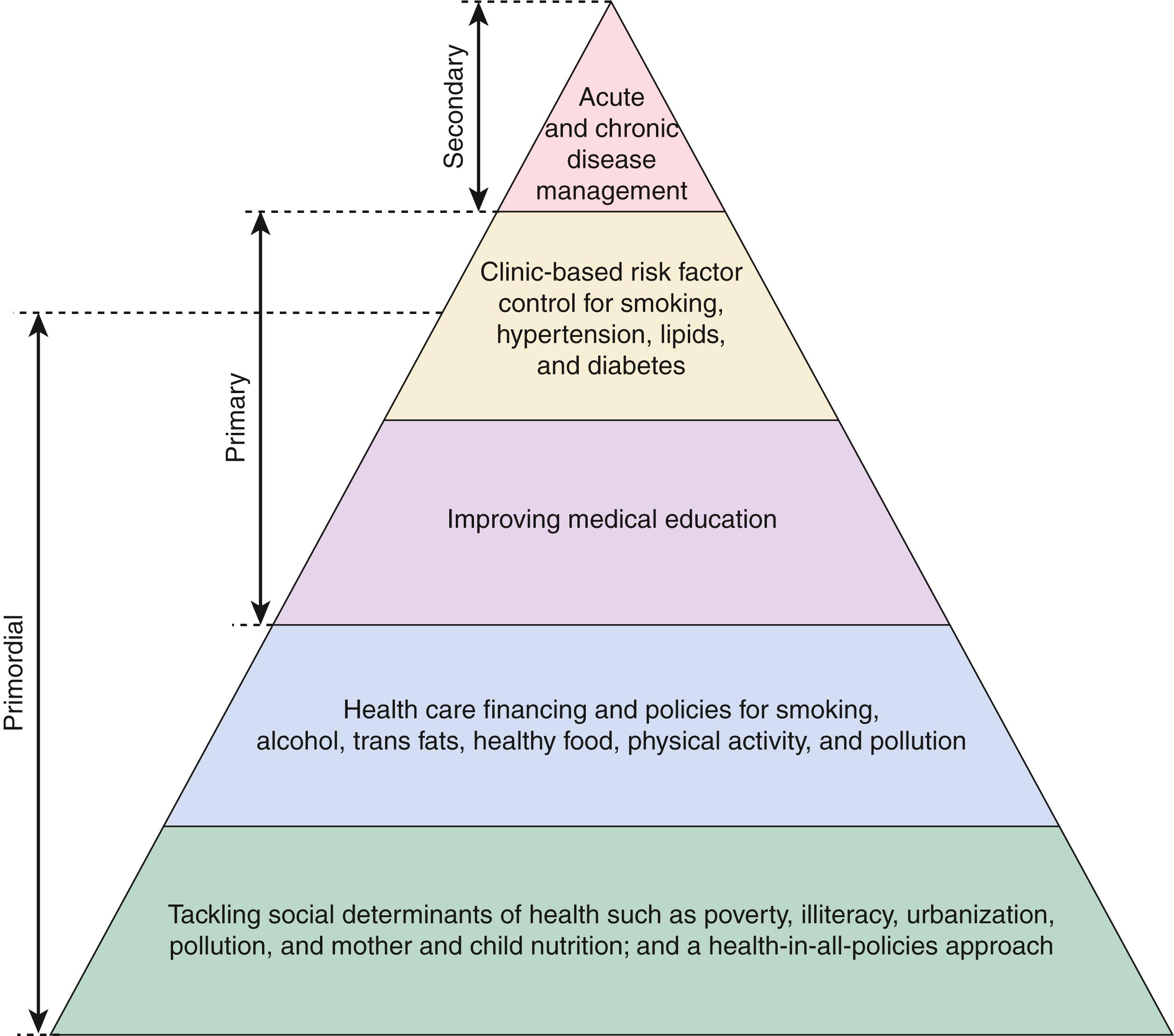
Lifetime cardiovascular risk estimates suggest that lowering the burden of cardiovascular disease requires all three types of prevention. The American Heart Association (AHA) guidelines emphasize the importance of primordial prevention by addressing the impact of social determinants of health. The World Health Organization also recommends this approach to achieve its noncommunicable disease goals (United Nations Sustainable Development Goals), in particular for improving daily living conditions and distribution of power, money, and resources. This model of “health-in-all-policies” includes universal health care, better health care financing, and improvements in agriculture, transportation, and employment, in addition to reducing poverty, illiteracy, smoking, alcohol abuse, and poor diet. Scandinavian countries which now have the lowest ischemic heart disease prevalence in Europe have demonstrated the success of this approach.
Primordial and primary prevention can eliminate most cardiovascular events. In the Prospective Urban Rural Epidemiology (PURE) study of 155,722 participants (mean age 50 years) from 21 countries followed for nearly a decade, greater than 70% of cardiovascular disease and myocardial infarction cases could be attributed to a small number of modifiable risk factors, consistent with prior results from the Global Burden of Disease and other studies. The largest contribution to cardiovascular risk was from metabolic risk factors (41% of the population attributable fraction) of which 22% were attributed to hypertension followed by non-HDL cholesterol (8%), while the biggest contribution to all-cause deaths was from behavioral risk factors (26%) and low education (12.5%). For myocardial infarction, the largest risk factor was high non-HDL cholesterol, followed by hypertension, smoking, abdominal obesity, and diabetes. Population-based interventions that aim to improve nationwide health include bans on trans fats and smoking, reducing salt, sugar, and alcohol intake, and improving diet and physical activity. Disparities in cardiovascular disease could be reduced with multi-factorial programs for the entire population, plus more targeted interventions for specific high-risk communities and individuals. Healthy People 2020 and 2030 are national initiatives in the United States designed to improve health for all population groups and eliminate disparities by emphasizing key cardiovascular health goals and tracking them.
Maintaining cardiovascular health across the lifespan is critical for primary prevention and depends on health-promoting activities that occur both within and outside of the health care system. The AHA introduced Life’s Simple 7 cardiovascular health metrics in 2010 to shift the focus from disease toward cardiovascular and overall health and well-being. The seven health metrics are smoking status, body mass index (BMI), physical activity, diet, cholesterol, blood pressure, and glucose. Levels of poor, intermediate, and ideal health are defined for each metric, with ideal cardiovascular health defined as the absence of clinical cardiovascular disease together with ideal levels of all seven components in the absence of medication treatment ( Fig. 25.2 ). For US and non-US populations, the prevalence of 6 to 7 ideal metrics is low (approximately 0.5% to 15%), worse for diet and physical activity, differs by demographics (e.g., worse for African Americans and those with lower education), and associates with higher risk of cardiovascular disease, mortality, and other outcomes (cancer, depression, and cognitive impairment). By 2020, some of these metrics improved in the United States, with overall less smoking, more physical activity, and lower cholesterol, yet during the same time other metrics have worsened with increases in blood pressure, BMI, and diabetes mellitus, and in youth, lower activity and higher blood glucose. , While achieving ideal cardiovascular health throughout the lifetime confers most benefit when maintained throughout life, tracking with less subclinical atherosclerosis and fewer cardiovascular events, benefit also derived from starting at high cardiovascular health levels even if they decreased over time. Given that one in four children start with less-than-ideal cardiovascular health, and 70% experience decline in cardiovascular health by early adulthood, it is more important than ever to promote ideal cardiovascular health early in life in particular for children, adolescents, and young adults. Recognizing that behavior influences overall health and well-being, the 2030 AHA goals emphasize an even broader vision of health and well-being that includes health equity, with the goal to increase health-adjusted life expectancy (HALE), that is, the number of years that a population can anticipate living in good health (commonly known also as healthy life expectancy) from 66 years to at least 68 years of age in the United States and from 64 years of age to at least 67 years of age globally. This new focus on healthy life expectancy incorporates overall health, disease conditions, quality and longevity of life, and well-being, with an emphasis on equity and improvements for all.
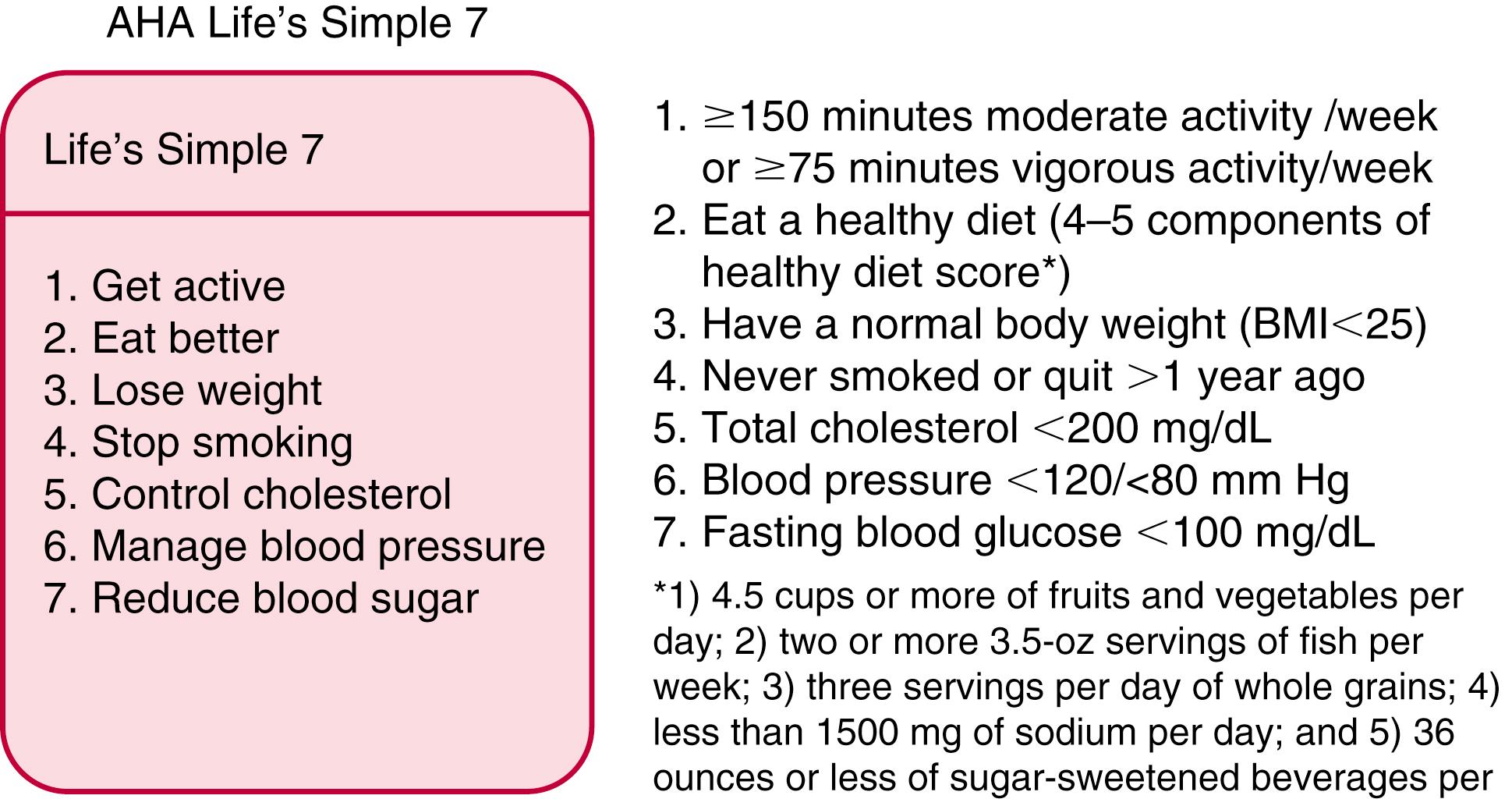
Current guidelines recommend targeting the intensity of preventive cardiovascular interventions (e.g., blood pressure lowering, cholesterol lowering, and aspirin when appropriate) to the level of the individual’s absolute risk. For almost half a century, interventions to reduce the risk of heart attack and stroke among adults without known cardiovascular disease have largely used a two-step process based on absolute risk. First, using a global risk–estimating algorithm for primary prevention in individuals ages 20 to 79 years old, 10-year risk is usually calculated and categorized into low, intermediate, and high. Then, based on shared decision-making, guidelines have traditionally targeted lifestyle interventions to those individuals at low risk while limiting pharmacologic interventions (such as statin therapy) to those with high-risk profiles, while sometimes recommending further laboratory or imaging assessments for refinement of risk among those at intermediate risk. In the United States, cardiovascular risk assessment used a global risk score such as that used in the third report of the Adult Treatment Panel of the National Cholesterol Education Program (ATP-III), a subsequent score that added family history of premature myocardial infarction and high-sensitivity C-reactive protein (hsCRP) to the traditional risk factors (the Reynolds risk score), or the most recent 2013 American College of Cardiology (ACC)/AHA atherosclerotic cardiovascular disease (ASCVD) risk assessment algorithm which is based on the Pooled Cohorts Equations (PCE). ,
All of these scores predict absolute risk of an event over the subsequent 10 years using sex-specific equations that take into account age, blood pressure, antihypertensive medication use, smoking status, and cholesterol measurements, and some include history of diabetes either as a risk factor or as a cardiovascular disease risk equivalent. These global risk scores differ in the outcomes that they predict. For example, the ATP-III risk score (also known as the Framingham risk score) predicted hard coronary heart disease events (myocardial infarction and coronary death). By comparison, the Reynolds risk score and the PCE included stroke in addition to coronary heart disease to predict ASCVD, but while the Reynolds risk score included coronary revascularization, the PCE score did not. In addition, the scores differ somewhat in the variables and associated coefficients that are included in the equations. The ATP-III score excluded diabetes as it was considered a coronary risk equivalent, while diabetes was included in the other two scores. The Reynolds risk score is distinct in additionally including the use of an inflammatory biomarker (hsCRP) and family history. Finally, the PCE provides different equations for blacks and whites, while the other two do not. The PCE has good discrimination of cases and noncases (C-statistic generally >0.7) comparable to other scores. However, since the publication of the PCE, multiple studies have reported variable calibration, with apparent overestimation of risk in both United States and European populations which has been attributed to the study populations being highly selected, increasing use of concomitant preventive therapies such as aspirin and statins, decreasing ASCVD event rates, and under-ascertainment of event rates in more recent cohorts which usually rely on participant self-reports for identifying potential events. Hence it is important that clinicians be aware of the baseline prevalence of ASCVD in their clinic population and other relevant characteristics that may influence the pretest probability (e.g., socioeconomic status, lifestyle, comorbidities). Overprediction of risk may be more pronounced in income strata such as individuals with higher socioeconomic status, while underprediction of risk may pertain to those with lower socioeconomic status or high-risk ethnic groups.
The cut points for low, intermediate, and high risk also have changed over the past few decades. The 2013 AHA/ACC guidelines recommended that the intermediate-risk category be expanded to include individuals with a 10-year absolute risk of a hard event of greater than 5% to 20%, with the argument that this lower 5% cut point for intermediate risk identifies a group of individuals, especially women or younger individuals, who may benefit more from more aggressive lipid-lowering and lifestyle modification as compared to those with a 10-year absolute risk less than 5%. The 2018 and 2019 guidelines recommended to further divide the intermediate risk category into “borderline” (5% to <7.5%) and “intermediate” subgroups (7.5% to <20%). ,
Several variations of the US scores have been developed in Europe, such as the European Society of Cardiology (ESC) recommended SCORE (Systematic Coronary Risk Evaluation, predicting fatal cardiovascular events) and the UK’s QRISK (which incorporates family history and social deprivation to predict cardiovascular events). , Estimating 10-year cardiovascular risk in low- and middle-income countries has expanded with the World Health Organization CVD risk chart that estimates 10-year risk of fatal and nonfatal cardiovascular disease in 21 world regions from greater than 1 million individuals, finding substantial variation in risk across regions.
While robust evidence exists that changing some of the modifiable risk factors that comprise the global risk scores (e.g., blood pressure management, cholesterol lowering, smoking cessation) decreases cardiovascular risk, it is unclear if providing global risk information to patients or clinicians results in better outcomes. In a Cochrane review of 41 randomized trials from 6422 reports involving 194,035 participants without cardiovascular disease, providing risk score information slightly improved cardiovascular risk factors and resulted in greater preventive medication use without evidence of harm, but there was substantial heterogeneity across the studies and the evidence was rated as low quality. This result agreed with an overview of systematic reviews that included both trials and observational studies.
Lifetime risk assessment was developed to address limitations of 10-year risk assessments and has been highlighted in recent guidelines. , Since age is the predominant determinant of cardiovascular risk, risk may be underestimated by relying on short-term (10-year) risk in younger individuals with multiple risk factors in whom cumulative exposure to these risk factors may be substantial over a lifetime, whereas older individuals with optimal levels of risk factors may have their risk overestimated as they are deemed high risk based on their age alone. Within the low- and intermediate-risk groups, there is variation in lifetime risk. To address this limitation, lifetime risk assessments (e.g., QRISK-Lifetime, Million Hearts longitudinal ASCVD risk assessment tool, LIFE-CVD) estimate risk over longer periods, yet such scores may not be accurate given that they may be derived from older cohorts, may not account for change in risk factors over time, or may be limited by disease ascertainment. Future risk scores should also address cumulative exposure and change in risk factors over time as well as comorbidities or factors that may modify risk. Finally, while risk estimates (short- or long-term) may inform shared decision-making discussions between clinicians and patients regarding initiation and maintenance of therapies, as well as quality assessments when risks and benefits of interventions are in question, it is important to remember that all risk estimates are probabilities of future clinical disease, and do not provide diagnostic or prognostic certainty.
In contrast to biologic factors that predispose to disease and are included in global risk scores, direct imaging of preclinical atherosclerosis provides an alternative method to detect high-risk individuals who might benefit from early preventive interventions. Of several imaging techniques developed over the past decade, computed tomography to detect coronary artery calcification (CAC) has emerged as a leading imaging tool for the preventive cardiology community.
The advantages of CAC include wide availability, consistency across epidemiologic cohorts, and reproducible findings with regard to cardiovascular risk. CAC augments risk prediction across the full spectrum of primary prevention patients using either contemporary ESC or AHA/ACC guidelines ( eFig. 25.2 ). The AHA/ACC guidelines suggest use of CAC among those with estimated 10-year risk between 5% and 20% in the context of shared decision-making when either the physician or patient is otherwise uncertain about use of specific preventive therapies, in particular statins. , CAC may also identify high-risk patients who would benefit from diet, exercise, smoking cessation, and other behavioral intervention, yet who have lacked motivation to do so. Some preventive cardiologists employ CAC scanning in lower-risk patients when there is a family history of premature coronary artery disease (see also Family History).
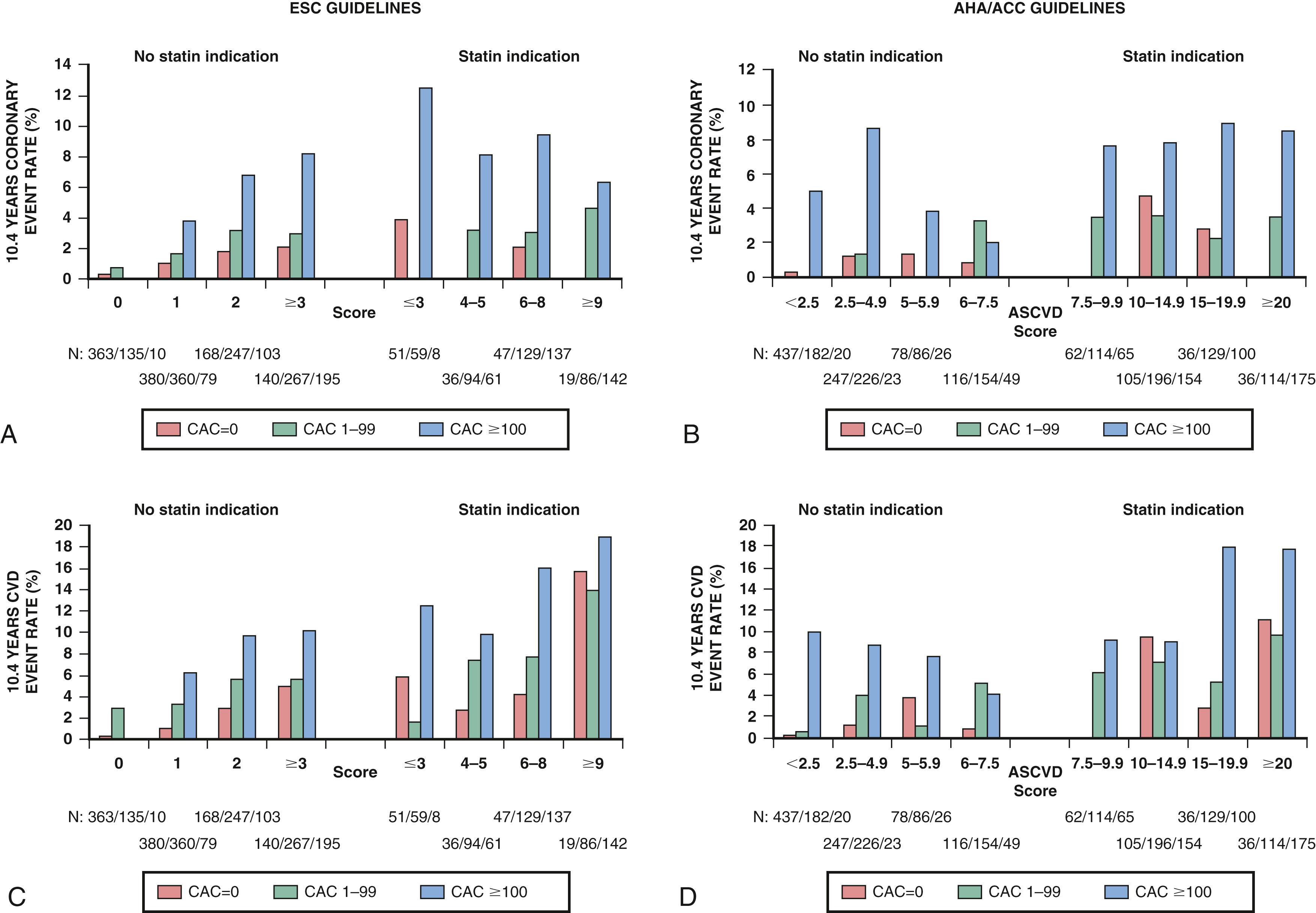
However, CAC scanning even with modern technology entails radiation exposure and results in increased downstream testing consequent to unanticipated false-positive findings particularly when tomography includes the full pulmonary bed. Further, therapeutic trials based on CAC are lacking (in contrast for example to LDL cholesterol or high-sensitivity C-reactive protein [hs CRP]) and evidence is inconsistent as to whether knowledge of CAC changes patient behaviors. In addition, CAC only detects calcified plaques (which are less likely to rupture) and does not detect the noncalcified thin-capped lesions that underlie many clinical events; as such, even CAC scores of zero do not eliminate atherosclerotic risk, particularly over long-term follow-up, and repeat testing after 5 years may be needed. Finally, as statins increase rather than reduce coronary calcification, scanning those already taking these agents has little utility, and repeat testing has no role once a decision to start lipid-lowering has been made. Patterns of CAC use thus vary widely in the preventive cardiology community; among those favoring imaging, utilization of CAC has clearly increased while measures of carotid intimal medial thickness have waned.
The second imaging modality gaining broader acceptance in the prevention community is coronary computed tomographic angiography (CCTA; see Chapter 20 ). In the open-label, parallel-group SCOT-HEART trial of 4146 patients with stable chest pain, participants randomized to CCTA as compared to usual care had a lower rate of nonfatal myocardial infarction or coronary death at 5 years, an effect due to earlier use of coronary revascularization and more aggressive use of preventive and anti-anginal therapies. Further, while obstructive coronary disease was more prevalent among those with prior coronary disease events than among those with possible angina or those with non-anginal symptoms, the benefits of CCTA seen at 5 years were present among all three of these groups ( eFig. 25.3 ). Moreover, among patients with stable chest pain, low-attenuation noncalcified plaque burden most strongly predicted fatal or nonfatal myocardial infarction, irrespective of risk score, CAC, or coronary artery area stenosis, and nearly half of all incident infarctions occurred among those without clear obstructive disease. These emerging data suggest that use of CCTA in high-risk secondary prevention can improve certainty of the diagnosis of obstructive coronary disease, better target angiography and revascularization, and results in higher levels of prescription and adherence to preventive therapies. Given recent trial evidence that those with moderate ischemia do not preferentially benefit from an initial invasive as compared to conservative strategy, use of CCTA may increase in the future though its superiority over functional testing using exercise electrocardiography, nuclear stress testing, or stress echocardiography remains uncertain (see Chapter 14, Chapter 18 ).
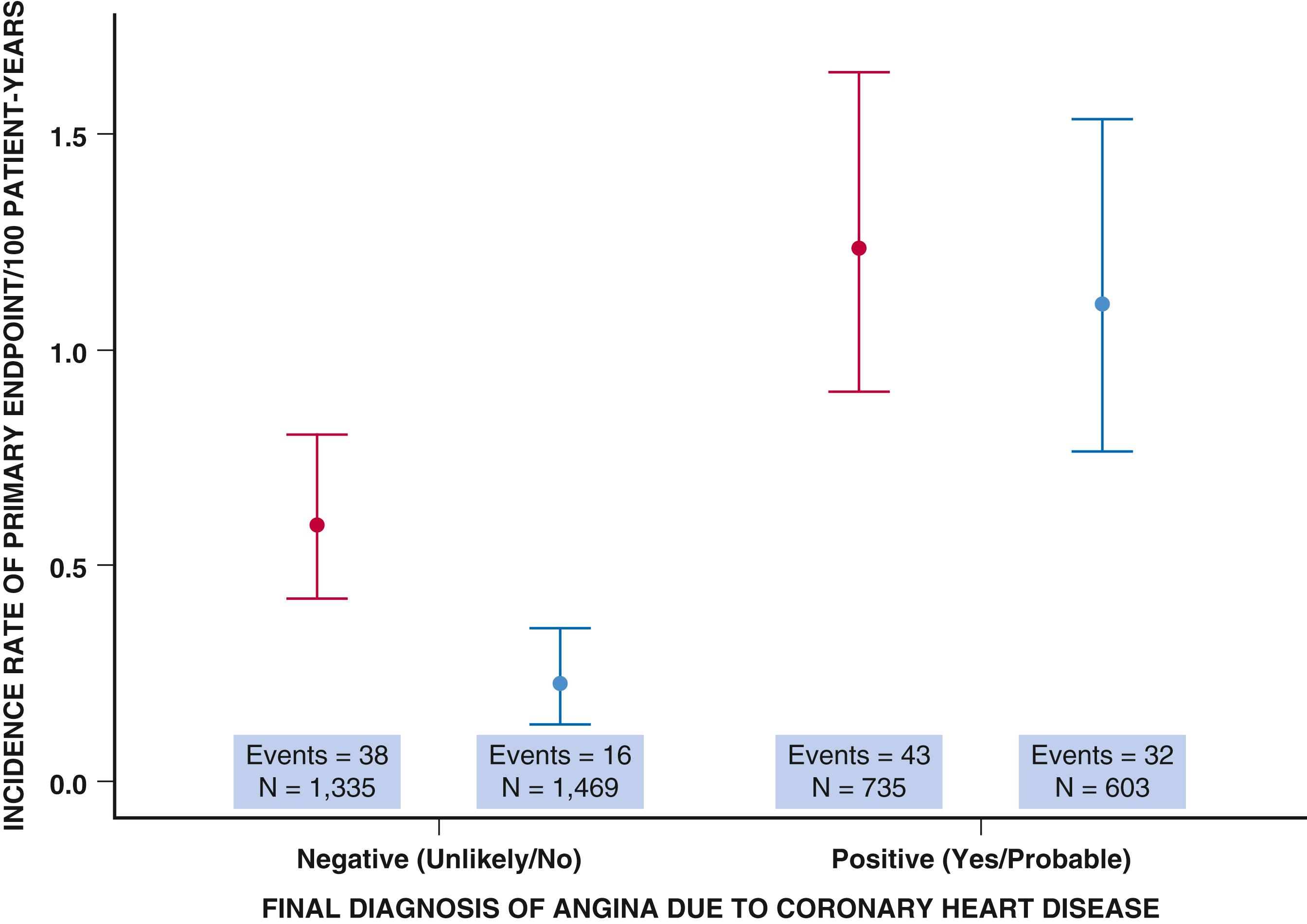
The 2018 and 2019 AHA/ACC cholesterol and prevention guidelines are summarized in Fig. 25.3 and Table 25.1 , , and the European guidelines are summarized in Table 25.2 . The US and European guidelines share many recommendations, but European guidelines additionally recommend treatment goals for lipids. A healthy lifestyle remains the foundation for cardiovascular risk reduction across the life span. Class I recommendations for statin therapy include three subgroups of patients: (1) patients from secondary prevention with clinical ASCVD (history of acute coronary syndrome, myocardial infarction, stable or unstable angina, coronary or arterial revascularization, stroke, transient ischemic attack, or peripheral arterial disease) should be treated with maximally tolerated statin and nonstatin therapy to achieve LDL cholesterol reduction of 50% or more, (2) individuals from primary prevention with LDL cholesterol greater than or equal to 190 mg/dL, as this indicates primary hypercholesterolemia and should be treated with high-intensity statin or the highest intensity tolerated, aiming for LDL cholesterol reduction of 50% or more which can be achieved with addition of non-statin medication, and (3) patients from primary prevention with diabetes, age 40 to 75 years old, and LDL cholesterol 70 to 189 with no clinical ASCVD, should be treated with moderate-intensity therapy, or high intensity if multiple ASCVD risk factors present in addition to diabetes. The guidelines recommend assessing 10-year ASCVD risk every 5 years in all asymptomatic adults age 40 to 75 years old, using the sex- and race-specific PCE. In individuals with borderline (5% to <7.5%) or intermediate (7.5% to <20%) risk, the guidelines recommend refining risk by assessing lifetime risk, use of clinical risk enhancers (see Table 25.1 ), or if there is still uncertainty about the risk estimate, then using CAC to evaluate for subclinical coronary atherosclerosis and reclassify risk. These factors should enter into the clinician-patient discussion to guide shared decision-making regarding starting statin therapy, in addition to considerations of adverse drug effects, drug-drug interactions, cost, and patient preferences.
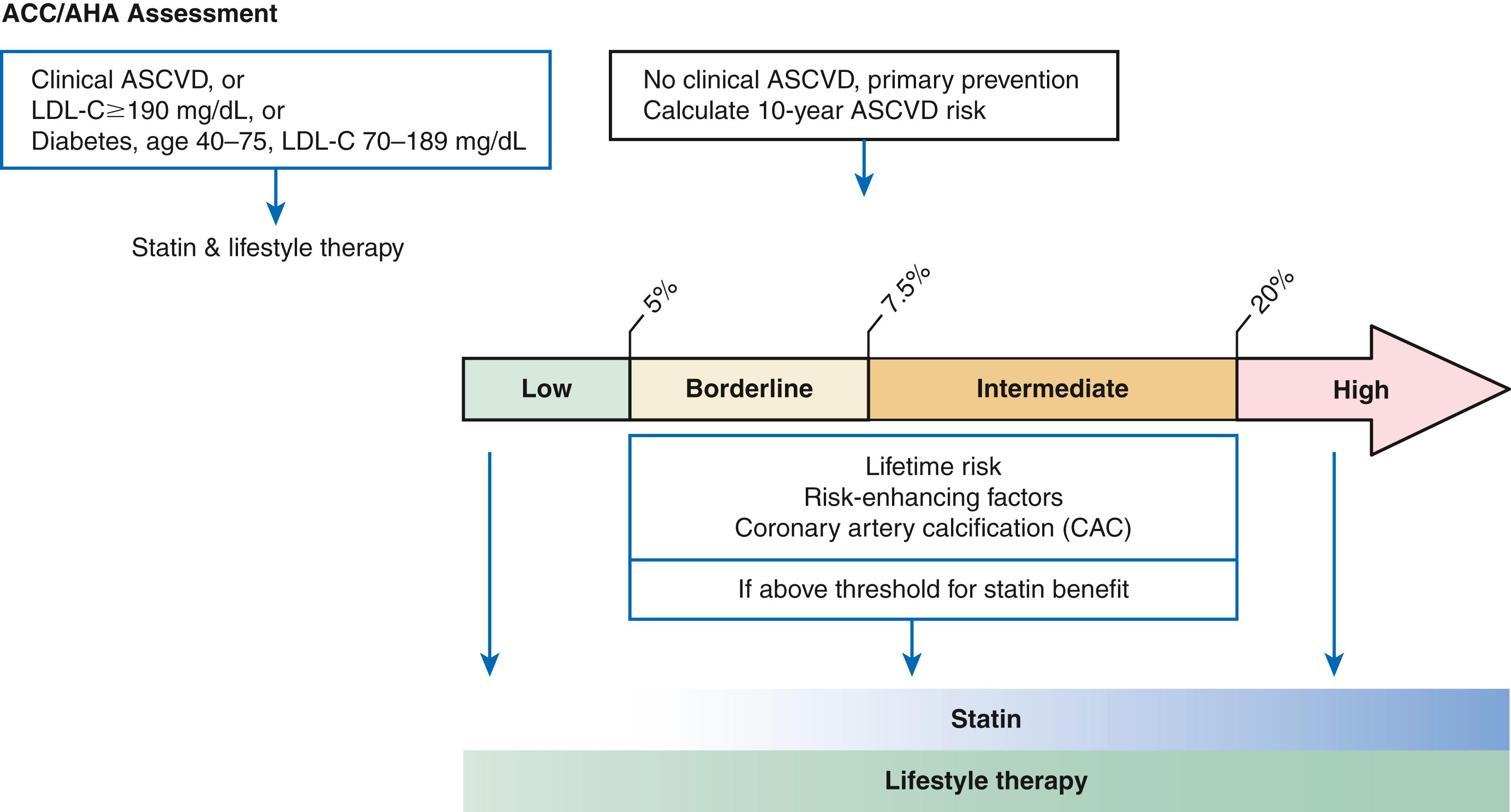
| Family history of premature ASCVD (men <55 years, women <65 years) |
| Primary hypercholesterolemia (LDL-C ≥160 mg/dL [4.1 mmol/L]; non-HDL-C ≥190 mg/dL [4.9 mmol/L]) |
| Chronic kidney disease (eGFR 15–59 mL/min/1.73 m 2 , not on dialysis or kidney transplant) |
| Metabolic syndrome |
| Conditions specific to women (e.g., preeclampsia, premature menopause) |
| Chronic inflammatory conditions (especially rheumatoid arthritis, lupus, psoriasis, HIV) |
| High-risk race/ethnicity (e.g., South Asian ancestry) |
| Lipids/Biomarkers |
| Persistently elevated triglycerides (≥175 mg/dL [2 mmol/L], fasting or nonfasting) |
| In selected individuals if measured: |
| hsCRP ≥2 mg/L |
| Lipoprotein(a) ≥50 mg/dL or ≥125 nmol/L |
| Apolipoprotein B ≥130 mg/dL |
| Ankle-brachial index <0.9 |
CVD risk estimation
Lipid analyses for CVD risk estimation
Treatment goals for LDL-C in primary prevention
|
As described in the 2020 Surgeon General’s report on smoking, tobacco use remains the single most important preventable cause of death and disability in the United States. Approximately 34 million American adults smoke cigarettes, most on a daily basis, resulting in excess health care spending of $170 billion annually.
Cigarette consumption contributes causally to one of every five deaths in the United States; the majority due to complications of coronary disease, lung cancer, and chronic obstructive pulmonary disease. From a cardiovascular perspective alone, smoking doubles the incidence of coronary disease and increases coronary deaths by more than 50%, with risks increasing with age and the number of cigarettes consumed. Smoking further is associated with increased rates of recurrent myocardial infarction, sudden cardiac death, aortic aneurysm rupture, symptomatic peripheral arterial disease, ischemic stroke, hemorrhagic stroke, coronary bypass surgery, and percutaneous coronary interventions. In women, smoking acts synergistically with oral contraceptives, placing younger women at additionally elevated risks for venous thromboembolism. Smokers lose at least one decade of life expectancy compared with never-smokers. Mechanisms underlying these multiple adverse effects include smoking-induced elevations of blood pressure and vascular tone, coronary spasm, lowered arrhythmia thresholds, impaired endothelium-dependent vasodilation, systemic pro-inflammatory effects, spontaneous platelet aggregation, reduced fibrinolytic function, and augmented insulin resistance.
Largely as a result of aggressive public health campaigns, between 1965 and 2017, the prevalence of current smoking in the United States declined from 52% to 16% in men and from 34% to 12% in women ( eFig. 25.4 ). Smoking prevalence, however, is greater today among the young than among the elderly and there remain large disparities in tobacco use across strata defined by education, socioeconomic status, and ethnic background with the highest rates observed among adults living below the federal poverty level. By contrast to gains seen in North America, smoking prevalence is increasing in most developing economies worldwide. Today, more than 80% of the world’s 1 billion smokers live in low- and middle-income countries.
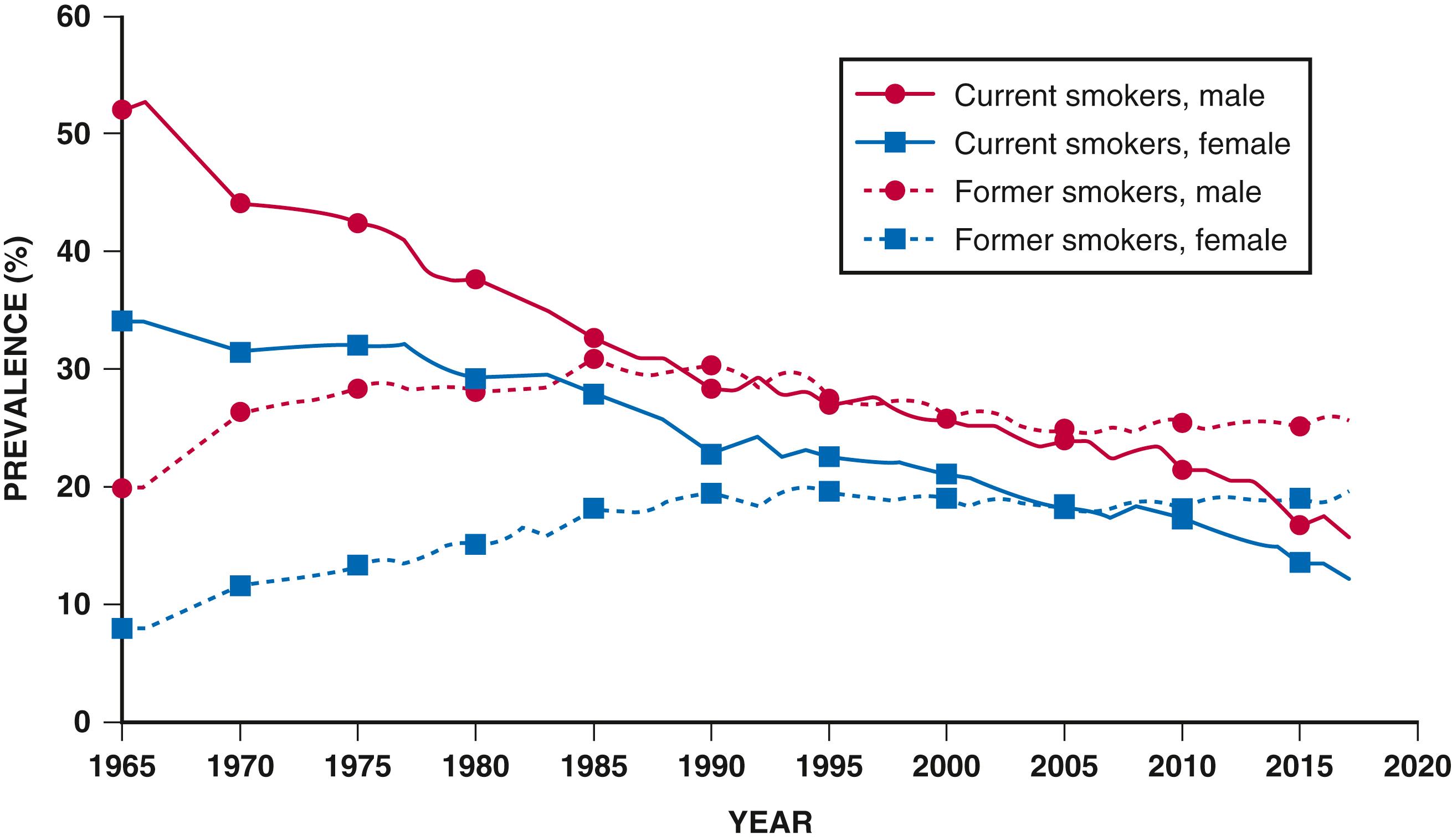
The Surgeon General’s 2020 report appropriately focuses on smoking cessation with an intent of helping all current smokers quit. US government-related interventions include the full funding of comprehensive statewide tobacco control programs, enforcing higher retail pricing of cigarettes to at least $10 per pack; complete protection of the US population from second-hand smoke; public funding of high-impact media campaigns; more aggressive product warnings; and ensuring barrier-free cessation insurance coverage. With regard to global health, the WHO EMPOWER program seeks on an international basis to increase pricing of tobacco products; promote anti-tobacco media campaigns; implement smoke-free laws for workplaces and public spaces; and most importantly place strong restrictions on the advertising and promotion of tobacco products.
At an individual level, multiple approaches to smoking cessation exist and can be effective. First and foremost, smokers need to understand that quitting will reduce the excess risk of a coronary event by 50% within the first 2 years after cessation, with much of this benefit seen within the first few months. Risk further falls within the first 1 to 2 years of cessation with the risk in former smokers approaching that of never smokers after 3 to 5 years. Moreover, the beneficial effects on cardiovascular disease and all-cause mortality accrue even in the elderly, supporting the idea that it is never too late to quit smoking for the purpose of reducing cardiovascular risk. The magnitude of benefit conferred by smoking cessation equals or exceeds that of alternative secondary prevention efforts that typically receive greater attention from physicians and the pharmaceutical industry, including the use of lipid-lowering drugs. Unfortunately, though the elevated cardiovascular risks associated with smoking diminish significantly after cessation, the risks for development of cancers of the lungs, pancreas, and stomach persist for more than a decade.
Three of five US adults who have ever smoked have quit, and roughly two of every three current smokers want to quit. Many insurers now cover behavioral approaches and pharmacotherapy for smoking cessation. As of 2019, the US Food and Drug Administration has approved five nicotine replacement therapies and two non-nicotine oral medications that target smoking cessation, agents considered cost-effective. Implementation programs have shown effectiveness across multiple settings, including among low-income populations. Recent evidence suggests that combinations of short- and long-term nicotine replacement therapies may increase smoking cessation efficacy, as do text messaging services and web-based interventions that can serve as positive reminders and incorporate behavioral change techniques. A 2019 Cochrane review of 51 trials inclusive of 22,000 people found no overall difference in effectiveness between abrupt quitting and reduction-to-quit interventions, although with use of varenicline as a reduction aid the reduction-to-quit approach did appear somewhat better. Reduction aided by fast-acting nicotine replacement or varenicline was modestly better than reduction without pharmacologic aid, but this was not seen with nicotine patch or bupropion pharmacologic therapies. A previous Cochrane review found that nicotine replacement could be effective both with and without counseling and found no evidence that nicotine replacement increased short-term vascular risk.
Whether or not nicotine exposure from e-cigarettes reduces long-term risks of heart disease and lung cancer when compared to traditional smoking remains controversial, as is the premise that e-cigarettes in general lead to smoking cessation; the Surgeon General’s 2020 report explicitly found evidence supporting this hoped-for benefit inadequate (see Chapter 28 ). Initial promotion of e-cigarettes falsely presumed that vaping would not lead to new smokers nor impact upon the young. Quite to the contrary, while the prevalence of adult smoking has declined, the prevalence of e-cigarette use (vaping) has dramatically increased among youth. In a recent cross-sectional survey conducted in North America, e-cigarette use was 27.5% among high school students and 10.5% among middle school students. Much of this increase is due to flavored products specifically intended for a youth market, as less than 5% of adults report current e-cigarette use.
E-cigarettes certainly can cause a severe and life-threatening form of toxic inhalation pneumonitis known as e-cigarette or vaping associated lung injury (EVALI). EVALI represents an industry-induced health epidemic that could have been avoided had these products not entered the market in the first place. In response to these concerns, the Centers for Disease Control and Prevention has recommended that e-cigarette and related vaping products never be used by youths, young adults, or pregnant women. The above issues notwithstanding, preventing smoking in the first place must receive greater emphasis. School-, community-, and physician-based primary prevention remain the most important components of any smoking reduction strategy.
Elevated blood pressure is a major risk factor for cardiovascular diseases including coronary disease, heart failure, cerebrovascular disease, sudden cardiac death, peripheral arterial disease, renal failure, atrial fibrillation, and total mortality, as well as loss of cognitive function and increased incidence of dementia (see Chapter 26 ). Globally, hypertension affects an estimated 1 billion people, while systolic blood pressure ≥ 110 to 115 mm Hg affects 3.5 billion adults and accounts for approximately one in five total deaths (>10 million deaths) and more than half of cardiovascular deaths. Based on surveys from 154 countries with 8.69 million participants, the Global Burden of Disease study estimated that over the past 25 years the rates of annual deaths associated with systolic blood pressure ≥ 110 to 115 mm Hg increased from 135.6 to 145.2 per 100,000 adults, and annual deaths associated with systolic blood pressure ≥ 140 mm Hg increased from 97.9 to 106.3 per 100,000 adults. DALYs from cardiovascular and other diseases increased concomitantly (by 40%), with the greatest burden seen in five countries (China, India, Russia, Indonesia, United States). In 2015, elevated systolic blood pressure was the third-leading risk factor for global DALYs in both men and women, and the second-leading risk factor for DALYs from cardiovascular disease (dietary risks ranked #1) ( eFig. 25.5 ).
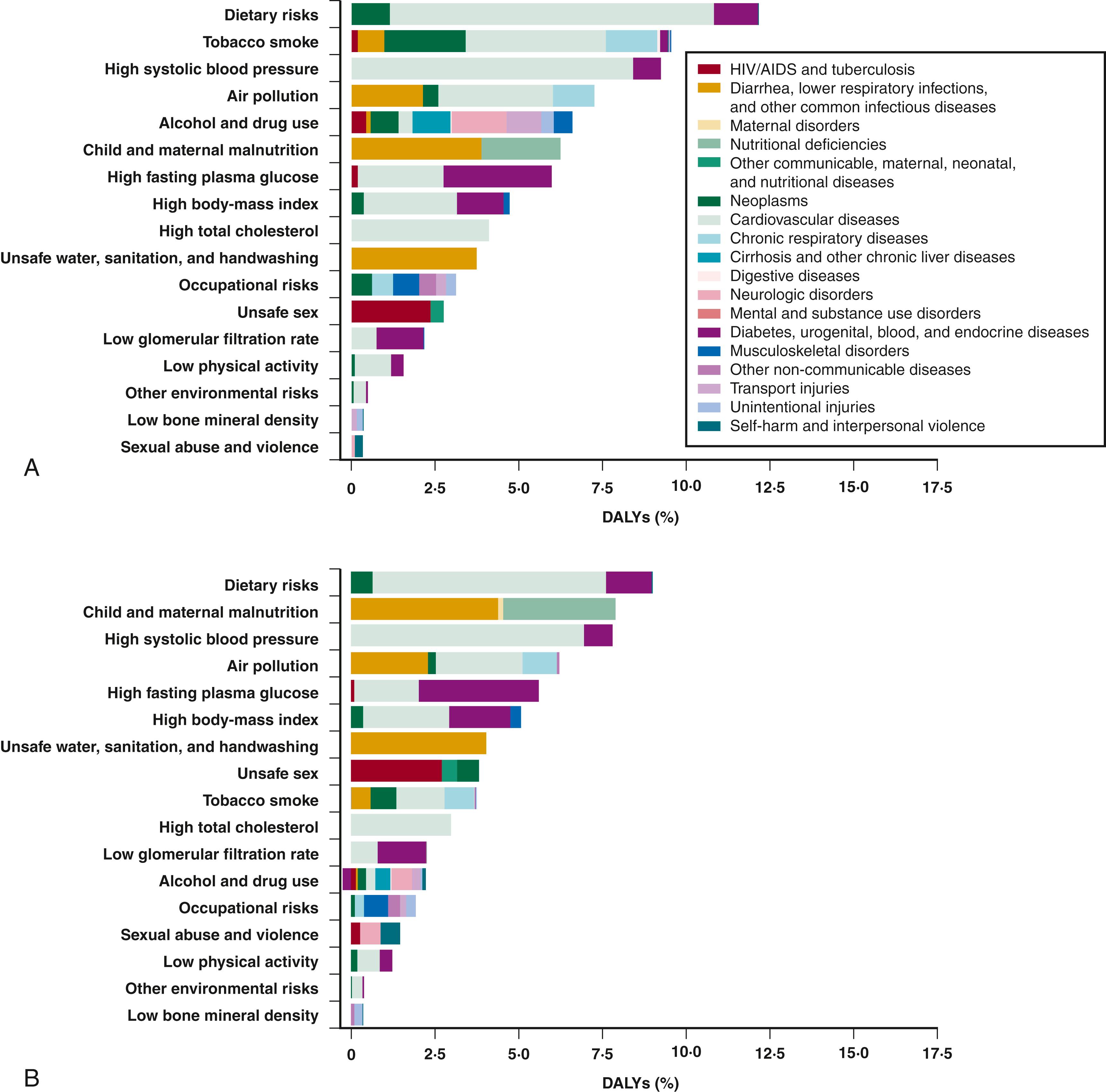
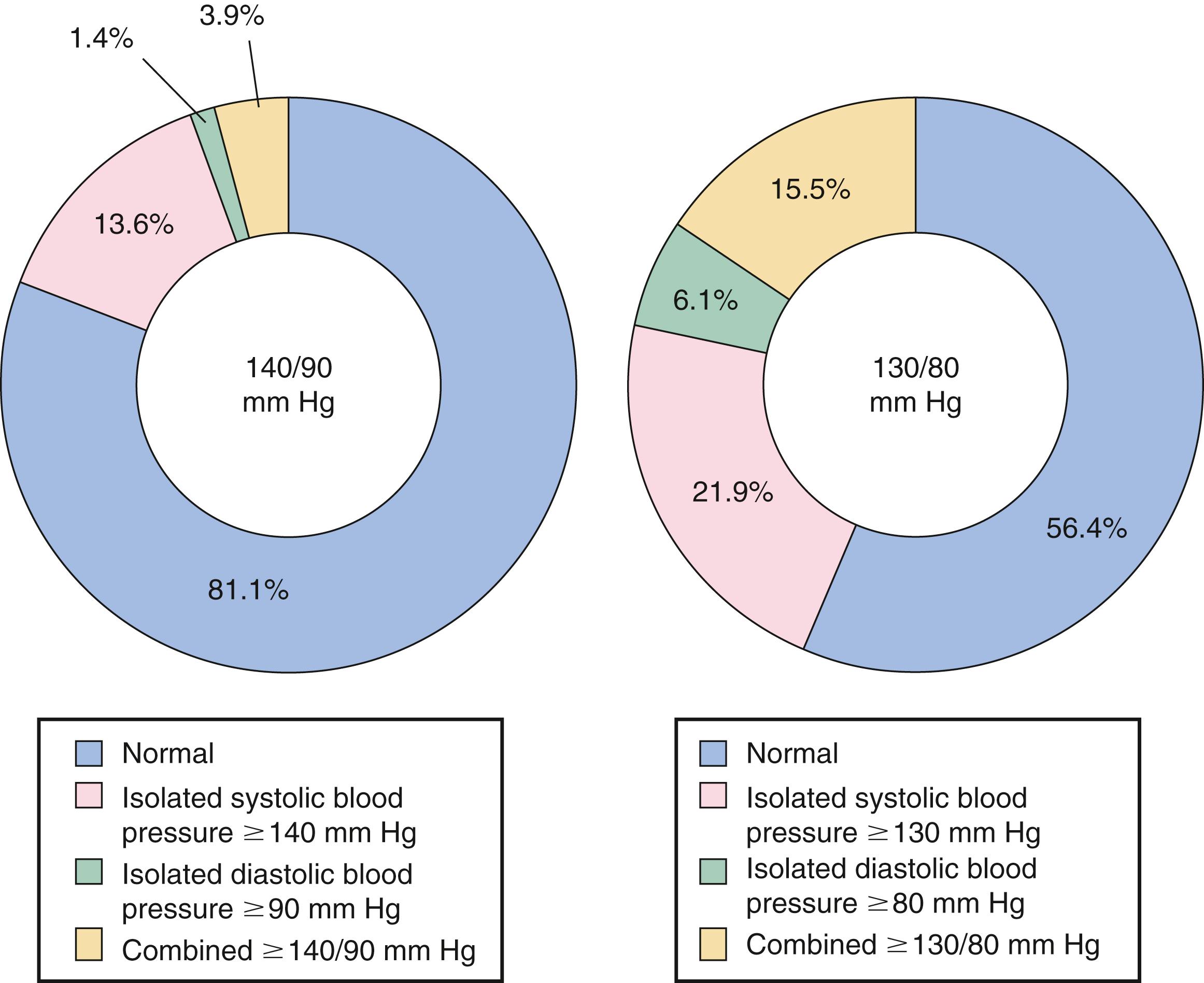
In the United States, 46% of Americans have hypertension (defined as systolic ≥130 or diastolic ≥80 mm Hg) ( eFig. 25.6 ), with an estimated lifetime risk ranging from approximately 70% for white women to greater than 85% for black men and women, yet the prevalence of hypertension is increasing across all race/ethnicity and age groups. Hypertension contributes to more cardiovascular deaths in the United States than any of the other major modifiable cardiovascular risk factors and is one of the most common reasons for clinic visits. Strong socioeconomic, racial/ethnic, and sex disparities persist in the prevalence of elevated blood pressure and in the timing of blood pressure transition in the life course (see Chapter 93 ). The prevalence of hypertension in blacks in the United States is among the highest in the world, and is increasing. The predominant drivers of elevated blood pressure are behavioral, specifically diet (high salt, low fruits, and vegetables), physical inactivity, and overweight/obesity, highlighting opportunities for prevention of cardiovascular disease and reducing mortality.
Prospective studies indicate that death from both coronary disease and stroke increases progressively from blood pressure levels as low as 115 mm Hg systolic and 75 mm Hg diastolic. Regardless of the definition of hypertension (≥130/80 or ≥ 140/90 mm Hg) both systolic and diastolic blood pressure are associated with risk as demonstrated in a study of 1.3 million US adults using electronic health care records, with systolic blood pressure having stronger association than diastolic blood pressure with cardiovascular outcomes.
The risk factors and markers for development of hypertension include increasing age, ethnicity, family history of hypertension, genetic factors, lower education and socioeconomic status, greater weight, lower physical activity, tobacco use, psychosocial stressors, sleep apnea, dietary factors (including increased dietary fats, higher sodium intake, lower potassium intake, tobacco, and excessive alcohol intake), and changes in the gut microbiome. The core strategies to prevent and treat high blood pressure are lifestyle (weight loss, sodium reduction, potassium supplementation, healthy diet, increased activity, and moderation of alcohol intake) and drug therapy. Controlling dietary and lifestyle risk factors can prevent much hypertension.
Diet is one of the main drivers for hypertension, and the benefits of healthy dietary interventions can lower blood pressure. A meta-analysis of 24 randomized controlled trials including greater than 23,000 individuals found that dietary modifications lowered blood pressure, with the Dietary Approaches to Stop Hypertension (DASH) intervention (low sodium combined with high fruits, vegetables, low-fat dairy, and naturally high potassium) having the largest mean effect on lowering blood pressure (up to −7.6 mm Hg reduction in systolic blood pressure, and −4.2 mm Hg reduction in diastolic blood pressure), with clinically meaningful blood pressure-lowering benefits also seen for low-sodium, high-potassium, low-calorie, or Mediterranean diets. Notably, blood pressure lowering by these dietary interventions resembles in magnitude drug monotherapy.
Physical activity protects against hypertension. In a meta-analysis of 29 studies of greater than 330,000 individuals, the risk of incident hypertension was lower by 6% for each 10 metabolic equivalents (MET hour/week) increment in leisure-time physical activity, with more benefit with higher activity (e.g., up to 33% lower risk of hypertension with 60 MET hour/week). In overweight or obese adults with elevated blood pressure or hypertension, weight loss through a combination of reduced intake and increased activity is a key recommendation to reduce blood pressure. Weight loss of 1 kilogram achieved through lifestyle/diet is associated with approximately 1 mm Hg systolic blood pressure reduction in a dose-response manner, with greater reductions in patients with higher blood pressures. ,
Initiation of drug therapy depends on blood pressure and the absolute level of cardiovascular risk. Multiple randomized trials in patients with hypertension have demonstrated that blood pressure reductions as small as 3 to 5 mm Hg result in large and clinically significant reductions in risk for stroke, cardiovascular mortality, congestive heart failure, and coronary disease in middle-aged subjects, elderly persons, and specified high-risk patients such as those with diabetes and peripheral arterial disease.
Insulin resistance and diabetes rank among the major cardiovascular risk factors; the presence of diabetes confers an equivalent risk to aging 15 years, an impact comparable with if not greater than that of smoking (see Chapter 31 ). More than one third of US adults (88 million people) have some degree of abnormal glucose tolerance or prediabetes, a condition along with obesity that markedly increases the risk for type 2 diabetes and premature atherothrombosis. Approximately 13% of US adults (34.1 million) have diabetes (most of which is type 2 diabetes), with significant heterogeneity by age, sex, race/ethnicity, and socioeconomic status, and it is estimated that by 2050 one in three US adults will have diabetes if current trends continue. A particular area of concern is the role of childhood adiposity as a future determinant of adult diabetes and cardiovascular risk. Overweight or obese children who become obese adults suffer concomitant increases in risks for development of type 2 diabetes, hypertension, dyslipidemia, and early-onset atherosclerosis, whereas obese children who avoid adult obesity avoid many of these complications.
Patients with diabetes have twofold to eightfold higher rates of future cardiovascular events as compared with age- and ethnically matched nondiabetic subjects, and 75% of all deaths in diabetic patients result from coronary disease. Compared with unaffected persons, patients with diabetes have a greater atherosclerotic burden in the major arteries, as well as of microvascular disease. Insulin resistance alone confers an elevated risk of congestive heart failure. Moreover, the risk of cardiovascular disease starts to increase long before the onset of clinical diabetes. These effects loom even larger in ethnic minority populations and in patients with other concomitant risk factors.
Although hyperglycemia associates with microvascular disease, insulin resistance itself promotes atherosclerosis even before it produces frank diabetes, and available data corroborate the role of insulin resistance as an independent risk factor for atherothrombosis. This finding has prompted recommendations for increased surveillance for the metabolic syndrome, a cluster of glucose intolerance and hyperinsulinemia accompanied by hypertriglyceridemia (both fasting and postprandial), low-HDL cholesterol levels, a predominance of small dense LDL particles and elevation of LDL particles and apolipoprotein B (apoB) levels, central obesity, hypofibrinolysis, hypertension, microalbuminuria, and elevated inflammatory biomarkers such as hsCRP. (See Chapter 27, Chapter 30, Chapter 31 .) ApoB or non-HDL cholesterol may be elevated in the absence of abnormal LDL cholesterol due to the excess of small dense LDL particles. , Controversy continues regarding insulin resistance as a unifying pathophysiologic pathway that accounts for all of the features of metabolic syndrome, and whether coalescence of risk factors incorporated in the concept of the metabolic syndrome augment risk over and above the sum of risk attributable to the individual components. Nonetheless, multiple studies document that individuals with the metabolic syndrome have elevated cardiovascular event rates. Increases in fasting glucose also associate with increased rates of cardiovascular deaths, cancer deaths, and nonvascular, noncancer mortality. Inflammation also provides a unifying concept that links elements of metabolic syndrome, and levels of hsCRP both predict incident diabetes and increase the specificity of metabolic syndrome definitions.
Despite ongoing controversies, many clinicians find the concept of metabolic syndrome useful because it fits the profile of many patients presenting in primary care in contemporary practice. Some argue that the concept of metabolic syndrome can encourage physicians to engage in tighter control of risk factors and lifestyle modification and to encourage patients to adhere to lifestyle modification or therapy designed to address the individual components of metabolic syndrome as mandated by prevailing guidelines. Skeptics, however, note the lack of evidence that the construct of metabolic syndrome can influence physicians or the public to adopt or maintain a healthy lifestyle or preventive therapies. The 2018 and 2019 AHA/ACC guidelines now consider the metabolic syndrome as a risk-enhancing factor to consider in shared decision making regarding statin initiation or intensification decisions (see Table 25.1 ), in particular among individuals who are borderline or intermediate risk based on their 10-year risk score. , Further, the guidelines provide diabetes-specific cardiovascular risk enhancers that are independent of other risk factors in diabetes, and these include long duration of diabetes, nephropathy (eGFR <60 mL/min/1.73 m 2 or albuminuria ≥ 30 μg albumin/mg creatinine), retinopathy, neuropathy, and ankle-brachial index (ABI) less than 0.9. , In addition to systemic metabolic abnormalities, hyperglycemia causes accumulation of advanced glycation end products associated with vascular damage. Diabetic and prediabetic patients also commonly have abnormalities of endogenous fibrinolysis and impaired endothelium-dependent (nitric oxide–mediated) vasodilation.
Therapeutic interventions for patients with diabetes are reviewed elsewhere (see Chapter 30, Chapter 31 ). Beyond diet, exercise, and other lifestyle interventions, multiple randomized trials now demonstrate cardiovascular risk reduction among those with diabetes using new classes of glucose-lowering agents, in particular for glucagon-like peptide-1 receptor agonists (GLP-1RA) and for sodium-glucose cotransporter 2 (SGLT-2) inhibitors, which both reduce cardiovascular events and improve glycemic control. , Almost all patients with diabetes should be considered for statin therapy ( Fig. 25.3 ), and the presence of diabetes-specific risk enhancers could be used in shared decision-making discussions about statin intensification. Statins plus fibrate or niacin combinations have not been shown to improve cardiovascular outcomes. However, the pharmaceutical grade preparation of the n-3 fatty acid eicosapentaenoic acid (EPA, icosapent ethyl) administered in high dose (2 g twice daily) to patients who met the entrance criteria for REDUCE-IT did benefit (see Chapter 27 ). Low-dose aspirin may be considered for primary prevention of cardiovascular disease in patients with diabetes and increased cardiovascular risk who are not at increased risk of bleeding given the recent ASCEND trial showing 12% risk reduction in the primary cardiovascular endpoint, although at the cost of 30% increased risk of major bleeding, while aspirin should be used in those with diabetes and cardiovascular disease unless there is a contraindication (see section on Aspirin). Surgical approaches to diabetes and diabetes prevention can prove effective and in selected patients, metabolic surgery can provide long-term glycemic control, reductions in event rates, and increased longevity (see Chapter 30 ).
Regrettably, though lifestyle recommendations remain a core concern for obesity and diabetes prevention, interventions to improve fitness and lose weight have had limited long-term success even among highly motivated patients. These findings suggest the need for novel approaches to diabetes prevention that better integrate social supports and issues of poverty and food quality along with medical and surgical interventions.
Across all ethnic and race groups, across genders, and across all socioeconomic levels, obesity is a major risk factor for premature death, elevated morbidity, lost productivity, and increased medical costs of care. Unfortunately, obesity is very difficult to treat after it has developed, and thus prevention of unhealthy weight gain is easier and more effective than reversing it afterward.
An assessment of weight, height, and a calculation of BMI should be part of every cardiovascular prevention visit. BMI is calculated as weight in kilograms divided by height in meters squared; using this metric, a BMI of ≥25 kg/m 2 is considered “overweight,” a BMI ≥30 kg/m 2 is used to define “obesity,” and a BMI ≥35mkg/m 2 is used to define “severe obesity.” In turn, patients with a calculated BMI of 30 kg/m 2 or greater should be considered for intensive, multi-component behavior interventions and in some cases for drug and surgical therapy. Support for this recommendation comes, in part, from a recent meta-analysis inclusive of 122 randomized trials; compared to controls, participants in behavior-based interventions had greater weight loss (−2.4 kg) at 12 months and less weight regain (−1.6 kg) at 18 months. In the same meta-analysis, studies of medical interventions also improved outcomes modestly when added to a successful behavioral program, while both intervention strategies lowered the risk of developing diabetes among prediabetic patients. Weight-loss medications, but not behavioral interventions, associated with increased rates of harm, though these were of low absolute magnitude.
In the United States, obesity prevalence has increased in a stable and predictable manner over the past 30 years. Using state-level longitudinal BMI data from over 6 million adults participating in the Behavioral Risk Factor Surveillance Systems Survey which were corrected for self-reporting bias using direct obesity measures from the National Health and Nutrition Examination Survey, alarming trends in obesity can be projected forward on a regional basis ( Fig. 25.4 ) . Specifically, by 2030, nearly one in every two American adults is projected to be obese, with a prevalence higher than 50% in 29 states and not below 35% in any state. Moreover, if national trends do not change, nearly 25% of the United States will have “severe obesity” (BMI >35 kg/m 2 ), a category not even ascertained two decades ago. Reflecting the social determinants of health, all of these findings are more extreme among women, minorities, and those with low annual household incomes. Similar disturbing rates of increasing childhood obesity affect the entire United States.
![FIGURE 25.4, Estimated prevalence of obesity (body-mass index [BMI] >30 kg/m 2 ) in the United States, from 1990 to 2030 (left) and the most common projected BMI category in 2030 (underweight or normal weight, overweight, moderate obesity, or severe obesity), according to sex, race/ethnicity, and annual income (right) . FIGURE 25.4, Estimated prevalence of obesity (body-mass index [BMI] >30 kg/m 2 ) in the United States, from 1990 to 2030 (left) and the most common projected BMI category in 2030 (underweight or normal weight, overweight, moderate obesity, or severe obesity), according to sex, race/ethnicity, and annual income (right) .](https://storage.googleapis.com/dl.dentistrykey.com/clinical/PrimaryPreventionofCardiovascularDisease/9_3s20B9780323722193000256.jpg)
Obesity also has major adverse effects on global health. The worldwide prevalence of obesity is estimated to be 108 million children and 604 million adults, and the rate of increase in childhood obesity over the past 30 years has increased faster than the rate of adult obesity. Elevated BMI accounts for 4 million deaths globally with more than two-thirds related to cardiovascular disease.
Adult obesity strongly predicts incident cardiovascular and coronary diseases as well as hypertension, dyslipidemia, type 2 diabetes, osteoarthritis, sleep apnea, some cancers, low quality of life, depression, and anxiety, with risk increasing as BMI levels rise. Obese children have a risk for short-term health consequences including dramatic increases in insulin resistance, diabetes, breathing difficulties, and fractures. Obese children also have long-term risks for cardiovascular disease and diabetes as childhood obesity tracks closely with adult obesity. Nonobese adults who were overweight or obese during childhood have risks of these outcomes similar to those who were never obese.
Whether obesity is a “risk factor” or a “risk marker” is an area of long-term controversy in the epidemiologic community and helps to explain why BMI is not part of the traditional global risk scores. On the one hand, obesity tracks with diabetes, hyperlipidemia, and hypertension, all components of traditional risk scores. On the other hand, obesity tracks with prediabetic insulin resistance, low-grade systemic inflammation as measured by hsCRP, none of which usual preventive risk scores capture. An exception to this rule is the Reynolds Risk Score which also includes measures of inflammation and family history. The distribution of body fat also is a factor in the development of coronary disease, with abdominal obesity posing a substantial risk in both men and women. The waist-to-hip ratio, a surrogate for centripetal or abdominal obesity, independently predicts cardiovascular risk in women and older men. Chapter 30 discusses the mechanisms that link these anthropometric measures and cardiovascular risk.
Regardless of causal pathways, obesity challenges practitioners. Treatment strategies targeting obesity involve a multifaceted approach, including dietary counseling, behavioral modification, increased physical activity, psychosocial support, and potential pharmacologic and surgical interventions. Critical diet-related priorities to reduce adiposity include reductions in refined grains, starches, sugars, and processed meats and increasing intake of fruits, vegetables, nuts, fish, vegetable oils, and whole grains, in the context of regular physical activity. Data from numerous observational studies and short-term randomized trials support the substantial health benefits that accrue with weight loss. Even modest weight reductions of 5% to 10% confer significant improvement in blood pressure, improved lipoprotein profiles yielding lower levels of serum triglyceride-rich lipoproteins and LDL cholesterol while raising HDL cholesterol, and improvement in glucose tolerance and insulin resistance. However, behavioral weight loss trials have not definitively demonstrated reductions in incident cardiovascular events and mortality due primarily to participant inability to maintain weight loss on a long-term basis. Among motivated individuals, little convincing evidence establishes the superiority of any specific diet or dietary pattern in sustained weight reduction. Intermittent fasting displays diverse clinical benefits even in the absence of substantive weight loss. Dietary strategies relevant to cardiovascular disease prevention are discussed below.
By contrast to medical intervention trials, randomized trials indicate that metabolic surgery improves diabetes control, hypertension, lipid levels, sleep apnea, and osteoarthritis and show a trend toward improved mortality. (See Chapter 30 for details regarding operative approaches to obesity management.)
On a population basis, an increased intake of energy-dense foods and sugar-sweetened beverages, a decrease in physical activity, and an increase in sedentary behaviors because of changes in work, transportation, and urbanization all contribute to the obesity epidemic. Interventions to reduce obesity prevalence must therefore go beyond behavioral changes and medical prescriptions to include substantive societal change and government coordination. These concerns extend beyond the emerging economies; in the United States, three interventions can reduce childhood obesity and save more money than they cost to implement: the introduction of a sugar-sweetened beverage excise tax, elimination of the existing tax subsidy for advertising unhealthy food to children, and the provision of nutrition standards for food and beverages sold in schools outside of school meals. Critical examination should address how the built environment influences physical activity, diet, and weight change, and how government programs designed to oversee nationwide food production can inadvertently promote obesity both at home and abroad. Because a substantial burden of obesity and poor dietary intake exists among poor and less-educated groups, community-based efforts to make healthy choices an easier and more economic part of people’s lives is essential. Novel approaches can move beyond traditional environmental-focused policy measures, such as collaboration with the food and restaurant industry to achieve responsible marketing especially to children, expand available health food choices, and reduce fat, sugar, and salt content of processed foods. None of these interventions, however, can occur without broad political support, an effort that can and should involve the preventive cardiology community.
Premature cardiovascular disease generally refers to clinical cardiovascular disease occurring before age 65 years in women or before age 55 years in men, to distinguish it from conventional disease which occurs at older ages. Since cardiovascular disease drives much premature mortality, identifying individuals at risk of premature cardiovascular disease events is crucial. World leaders committed to reducing premature deaths from non-communicable diseases when the World Health Assembly and later the World Heart Federation adopted “25×25” to reduce these premature deaths by 25% by the year 2025 by improving 6 preventable factors (tobacco and alcohol use, salt intake, obesity, blood pressure, and glucose), and the United Nations Sustainable Development Goals aimed to reduce them by one-third by the year 2030 through prevention and treatment. At the global level, the increased burden of premature myocardial infarction has affected several countries including United Kingdom, Australia, Canada, and the United States, where the rates of myocardial infarction incidence and/or mortality among younger adults have decreased to a lesser extent and are possibly increasing, with worse outlooks for women than men.
Routine preventive practice should include evaluation of family history, and the 2018 and 2019 AHA/ACC guidelines now include family history of premature cardiovascular disease as a risk-enhancing factor that could be useful for initiating or intensifying statin therapy in adults with borderline or intermediate risk (see Table 25.1 ). , The guidelines now consider family history of premature ASCVD or genetic dyslipidemias an indication for assessing lipids and other risk factors, as well as a relative indication for measuring lipoprotein(a). A systematic review of 26 studies showed that a positive maternal or paternal history of cardiovascular disease conferred a similar degree of increased risk in the offspring by about 1.5- to 2-fold, with the highest risks observed for maternal history less than 50 years or paternal history less than 55 years ( Fig. 25.5 ). These effects compare in magnitude with those of smoking, hypertension, and hyperlipidemia. The Justification for the Use of Statins in Prevention: An Intervention Trial Evaluating Rosuvastatin (JUPITER) trial affirmed the importance of family history as a clinical marker of risk. Within JUPITER, those subjects with a family history of premature atherosclerosis experienced a 62% reduction in first vascular events associated with statin therapy as compared with a 39% reduction among those without a family history, with even greater statin-related risk reductions seen in women with family history versus men, which has led recent US guidelines to emphasize family history as a risk-enhancing factor when considering statin treatment. Even among individuals with coronary artery calcium (CAC) scores of 0, family history is associated with increased cardiovascular risk. Hence, family history could be considered a coronary disease risk equivalent for purposes of statin prescription in primary prevention. Several widely used global cardiovascular risk scores (e.g., Reynolds Risk Score and the PROCAM score) have incorporated family history of myocardial infarction at less than 60 years, highlighting the importance of family history as a variable that reflects both shared genetics and environment.
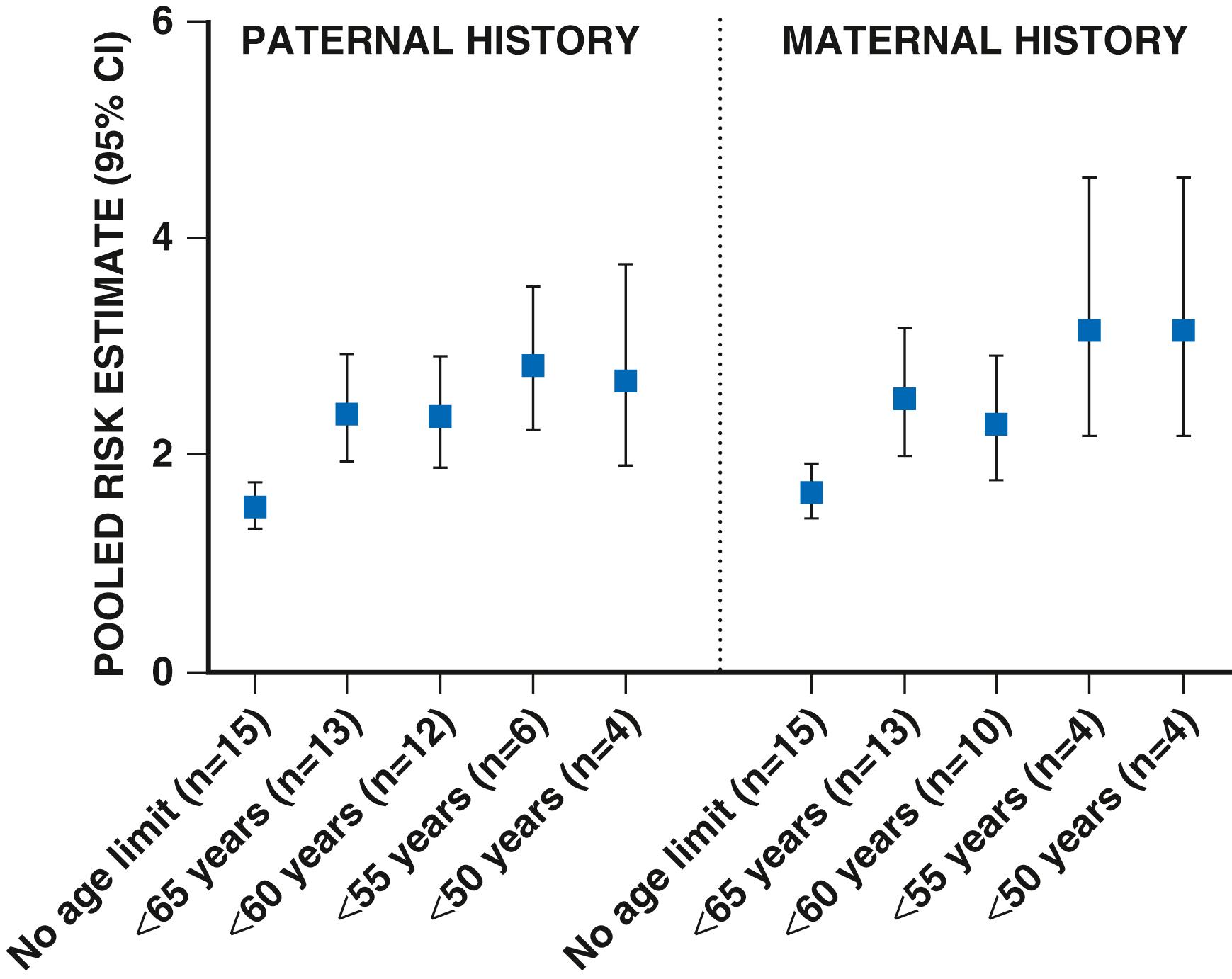
Become a Clinical Tree membership for Full access and enjoy Unlimited articles
If you are a member. Log in here